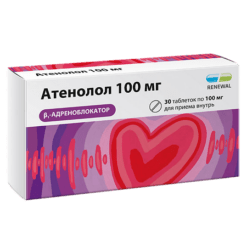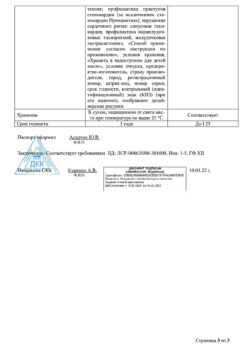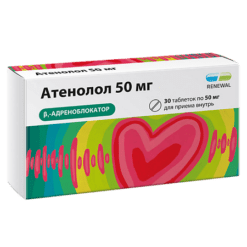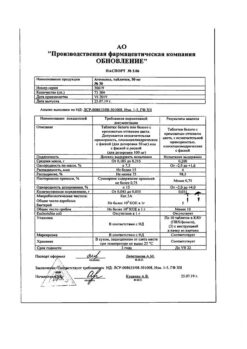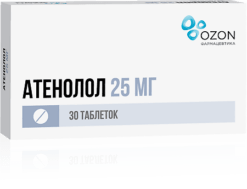No products in the cart.
Atenolol, tablets 50 mg 30 pcs
€1.00
Out of stock
(E-mail when Stock is available)
Description
Beta1-adrenoblocker. It has antianginal, antihypertensive and antiarrhythmic effects. Does not have membrane stabilizing and intrinsic sympathomimetic activity. Reduces catecholamine-stimulated formation of cAMP from ATP. In the first 24 hours after oral administration against the background of a decrease in cardiac output there is a reactive increase of total peripheral vascular resistance, which gradually decreases during 1-3 days.
The hypotensive effect is associated with decreased cardiac output, decreased activity of the renin-angiotensin system, baroreceptor sensitivity and influence on the central nervous system. The hypotensive effect is manifested by both a decrease in systolic and diastolic BP, and a decrease in stroke and minute volumes. In medium therapeutic doses, it has no effect on peripheral arterial tone. Hypotensive effect lasts for 24 hours and with regular use is stabilized by the end of the second week of treatment.
The antianginal effect is determined by decreasing myocardial oxygen demand as a result of decreasing heart rate (prolongation of diastole and improvement of myocardial perfusion) and contractility and decreasing myocardial sensitivity to sympathetic stimulation. It decreases HR at rest and during physical activity. By increasing left ventricular end-diastolic pressure and increasing ventricular muscle fiber stretch may increase oxygen demand, especially in patients with chronic heart failure.
The antiarrhythmic action is manifested by suppression of sinus tachycardia and is associated with the elimination of arrhythmogenic sympathetic effects on the cardiac conduction system, reduction of the rate of spread of excitation through the sinoatrial node and prolongation of the refractory period. It suppresses conduction of impulses in antegrade and, to a lesser extent, in retrograde direction through AV (atrioventricular) node and through additional conduction pathways.
The negative chronotropic effect appears 1 h after administration, reaches a maximum after 2-4 h, lasts up to 24 h.
Decreases sinus node automatism, decreases HR, slows AV conduction, decreases myocardial contractility, reduces myocardial oxygen demand. Reduces myocardial excitability. When used in medium therapeutic doses, it has less pronounced effect on the smooth muscle of the bronchi and peripheral arteries than non-selective beta-adrenoblockers.
Indications
Indications
– Arterial hypertension;
– Prevention of angina attacks: except for Prinzmetal angina;
– Heart rhythm disorders: sinus tachycardia, prevention of supraventricular tachyarrhythmias, ventricular extrasystoles, ventricular tachycardia.
Active ingredient
Active ingredient
Composition
Composition
Active ingredient:
atenololol 50 mg
Excipients: Lactose, corn starch, colloidal silicon dioxide, isopropyl alcohol, sodium lauryl sulfate, povidone, purified water, soluble Sun-Sen Yellow dye, purified talc, magnesium stearate, hydroxypropyl methylcellulose, titanium dioxide, methylene chloride, light liquid paraffin, polyethylene glycol.
How to take, the dosage
How to take, the dosage
Appoint orally before meals, do not chew, wash down with a small amount of liquid.
Arterial hypertension:
The treatment is started with 50 mg of Atenolol once daily. It takes 1-2 weeks of therapy to achieve a stable hypotensive effect. If hypotensive effect is not sufficiently pronounced, the dose is increased to 100 mg per dose. Further increase in dose is not recommended, since it is not accompanied by increase in clinical effect.
Stenocardia
The initial dose is 50 mg per day. If optimal therapeutic effect is not achieved within a week, the dose is increased to 100 mg per day. Sometimes it is possible to increase the dose to 200 mg, once a day. In elderly patients and patients with renal dysfunction the dose should be adjusted depending on creatinine clearance. In patients with renal insufficiency with creatinine clearance values higher than 35 ml/min/1.73 m3 (normal value is 100-150 ml/min/1.73 m3) there is no significant cumulation of atenolol.
The following maximum doses are recommended for patients with renal impairment.
Creatinine clearance (ml/min/1.73 m2)
Serum creatinine concentration (mmol/l)
Atenolol dose
15-35
300-600
50 mg per day
less than 15
more than 600
50 mg every other day or
Interaction
Interaction
Concomitant use of atenolol and insulin (or other oral antidiabetic agents) may increase their hypoglycemic effect.
When concomitant use with antihypertensive agents of other groups or nitrates, diuretics, sympatholytics there is an increase in the hypotensive effect.
The simultaneous use of atenololol and verapamil (or diltiazem) leads to a mutual enhancement of the cardiodepressant effect.
The hypotensive effect is weakened by estrogens (sodium retention).
The simultaneous use of atenolol and cardiac glycosides increases the risk of bradycardia and atrioventricular conduction disorders.
The simultaneous use of atenolol with reserpine, methyldopa, clonidine, verapamil may result in marked bradycardia. Atenolol and clonidine concomitantly administered should not be discontinued until several days after stopping treatment with atenolol.
Simultaneous intravenous administration of verapamil and diltiazem may provoke cardiac arrest, nifedipine may lead to a significant decrease in BP.
The concomitant use of atenolol with ergotamine derivatives, xanthine, nonsteroidal anti-inflammatory drugs reduces its effectiveness.
Simultaneous use with lidocaine may decrease its excretion and increase the risk of lidocaine toxicity.
The use together with phenothiazine derivatives, increases the serum concentration of each of the drugs.
When co-administered with euphylline and theophylline, mutual suppression of therapeutic effects is possible.
The concomitant use with MAO inhibitors is not recommended.
Allergens used for immunotherapy or allergen extracts for skin tests increase the risk of severe systemic allergic reactions or anaphylaxis.
Prolongs the effect of nonpolarizing myorelaxants, anticoagulation effect of coumarins.
Special Instructions
Special Instructions
Monitoring of patients taking atenololol should include monitoring of HR and BP (daily at the beginning of treatment, then once every 3-4 months), blood glucose content in diabetic patients (once every 4-5 months). In elderly patients it is recommended to monitor kidney function (once every 4-5 months).
The patient should be instructed on how to calculate heart rate and should be advised to consult a physician if the heart rate is less than 50 ppm.
In thyrotoxicosis, atenololol may mask certain clinical signs of hyperthyroidism (e.g., tachycardia). Abrupt withdrawal in patients with thyrotoxicosis is contraindicated because it can exacerbate symptoms. Unlike non-selective beta-adrenoblockers, it practically does not increase insulin-induced hypoglycemia and does not delay recovery of blood glucose concentration to normal levels.
In patients with coronary heart disease (CHD), abrupt withdrawal of beta-adrenoblockers may increase the frequency or severity of angina attacks, so discontinuation of atenololol in CHD patients should be done gradually.
Dose selection in patients with cardiac decompensation also requires special attention. Compared with non-selective beta-adrenoblockers, cardioselective beta-adrenoblockers have less effect on lung function, nevertheless in obstructive airway disease atenolol should be prescribed only in case of absolute indications. If it is necessary to prescribe them in some cases, beta 2-adrenomimetics may be recommended.
Atenolol masks the tachycardia that occurs during hypoglycemia and may increase the duration of hypoglycemic response to insulin. Caution should be exercised when concomitant use of atenolol and hypoglycemic drugs in patients with diabetes.
Patients with bronchospastic disorders may be prescribed cardioselective adrenoblockers in case of intolerance and/or ineffectiveness of other hypotensive drugs, but the dosage should be closely watched. Overdose is dangerous with the development of bronchospasm.
Particular attention is needed in cases where surgical intervention under anesthesia is required in patients taking atenolol. Administration of the drug should be discontinued 48 hours before surgery. As an anesthetic, the drug with the lowest possible negative inotropic effect should be chosen.
If atenolol and clonidine are used concomitantly, atenolol should be discontinued several days before clonidine in order to avoid the withdrawal symptoms of the latter.
The severity of hypersensitivity reactions and lack of effect of usual doses of epinephrine with a history of severe allergic reactions may increase.
Drugs that reduce catecholamine stores (e.g., reserpine) may increase the effects of beta-adrenoblockers, so patients taking these combinations of drugs should be kept under constant medical supervision for arterial hypotension or bradycardia.
The drug should be discontinued before testing blood and urine catecholamines, normetanephrine and vanillylmindalic acid; antinuclear antibody titers.
In elderly patients with significant bradycardia (less than 50 bpm), arterial hypotension (systolic BP below 100 mm Hg), AV blockade, bronchospasm, ventricular arrhythmias, severe liver or renal dysfunction, the dose should be reduced or the treatment should be stopped.
It is recommended that therapy be discontinued if depression develops as a result of taking beta-adrenoblockers.
If intravenous verapamil administration is necessary, this should be done at least 48 hours after taking atenolol.
The use of atenolol may decrease tear fluid production, which is important in patients who wear contact lenses.
The treatment should not be stopped abruptly because of the risk of severe arrhythmias and myocardial infarction. Withdrawal is done gradually, reducing the dose over 2 weeks or more (reduce the dose by 25% every 3 to 4 days).
The effectiveness of beta-adrenoblockers is lower in smokers.
During treatment, one must refrain from driving motor vehicles and engaging in potentially dangerous activities that require increased concentration and rapid psychomotor reactions.
Contraindications
Contraindications
Hypersensitivity to the drug, cardiogenic shock, atrioventricular block of II or III degree, expressed bradycardia, sinus node weakness syndrome, sinoauricular block, acute or chronic heart failure (decompensation stage), cardiomegaly without signs of heart failure, Prinzmetal angina, arterial hypotension (if used for myocardial infarction, systolic BP
Side effects
Side effects
The most common side effects are related to the main pharmacological effect of the drug and are expressed as follows:
cardiovascular system: the appearance of symptoms of heart failure, atrioventricular conduction disorder, bradycardia, marked decrease in blood pressure, palpitations; thrombosis.
Central nervous system disorders: Dizziness, sleep disturbance, decreased ability to concentrate, drowsiness, depression, hallucinations, lethargy, fatigue, headache, weakness, insomnia, nightmares, anxiety, confusion or short-term memory loss, impaired reactivity, paresthesias in the extremities (in patients with “intermittent” claudication and Raynaud syndrome), muscle weakness, seizures;
gastrointestinal side: dry mouth, nausea, vomiting, diarrhea, abdominal pain, constipation;
respiratory system: dyspnea, bronchospasm, apnea;
hematologic reactions: thrombocytic purpura, anemia (aplastic);
endocrine system disorders: gynecomastia, decreased potency, decreased libido; hyperglycemia (in patients with insulin-independent diabetes), hypoglycemia (in patients receiving insulin), hypothyroidism; metabolic reactions: hyperlipidemia;
dermal reactions: urticaria, dermatitis, pruritus, photosensitivity, increased sweating, skin hyperemia, exacerbation of the course of psoriasis;
Sensory organs: visual disturbance, decreased tear fluid secretion, dry and sore eyes, conjunctivitis, vasculitis, chest pain;
fetal effects: intrauterine growth retardation, hypoglycemia, bradycardia;
laboratory parameters: agranulocytosis, leukopenia, increased activity of “liver” enzymes and bilirubin levels;
other: “withdrawal” syndrome (increased angina pectoris attacks, increased BP), reversible alopecia, back pain, arthralgia.
The frequency of side effects increases with increasing the dose of the drug.
Overdose
Overdose
Symptoms: bradycardia, grade II-III atrioventricular block, marked decrease of blood pressure, increase of heart failure symptoms, bronchospasm, hypoglycemia, dizziness, fainting, arrhythmia, ventricular extrasystole, cyanosis of finger nails or palms, seizures.
In case of overdose, atenololol should be stopped and the patient should be under medical supervision.
Treatment: gastric lavage and administration of adsorptive agents. If bronchospasm occurs, inhalation or intravenous administration of beta 2-adrenomimetic salbutamol is indicated. In severe bradycardia 1 ml of 0.1% solution of atropine sulfate should be administered intravenously. In AV conduction disorders –
– epinephrine or placement of a temporary pacemaker, in ventricular extrasystole
– lidocaine (Class IA drugs are not used), in arterial hypotension – the patient should be in Trendelenburg position. If there are no signs of pulmonary edema – IV plasma substitute solutions, if ineffective – injection of epinephrine, dopamine, dobutamine, in heart failure – cardiac glycosides, in convulsions – IV diazepam. Dialysis may be performed.
Similarities
Similarities
Additional information
| Shelf life | 3 years. Do not use later than the date on the package. |
|---|---|
| Conditions of storage | In a dry, light-protected place at a temperature not exceeding 25°C. Store out of the reach of children. |
| Manufacturer | Borisov Medical Preparations Plant, Belarus |
| Medication form | pills |
| Brand | Borisov Medical Preparations Plant |
Other forms…
Related products
Buy Atenolol, tablets 50 mg 30 pcs with delivery to USA, UK, Europe and over 120 other countries.


